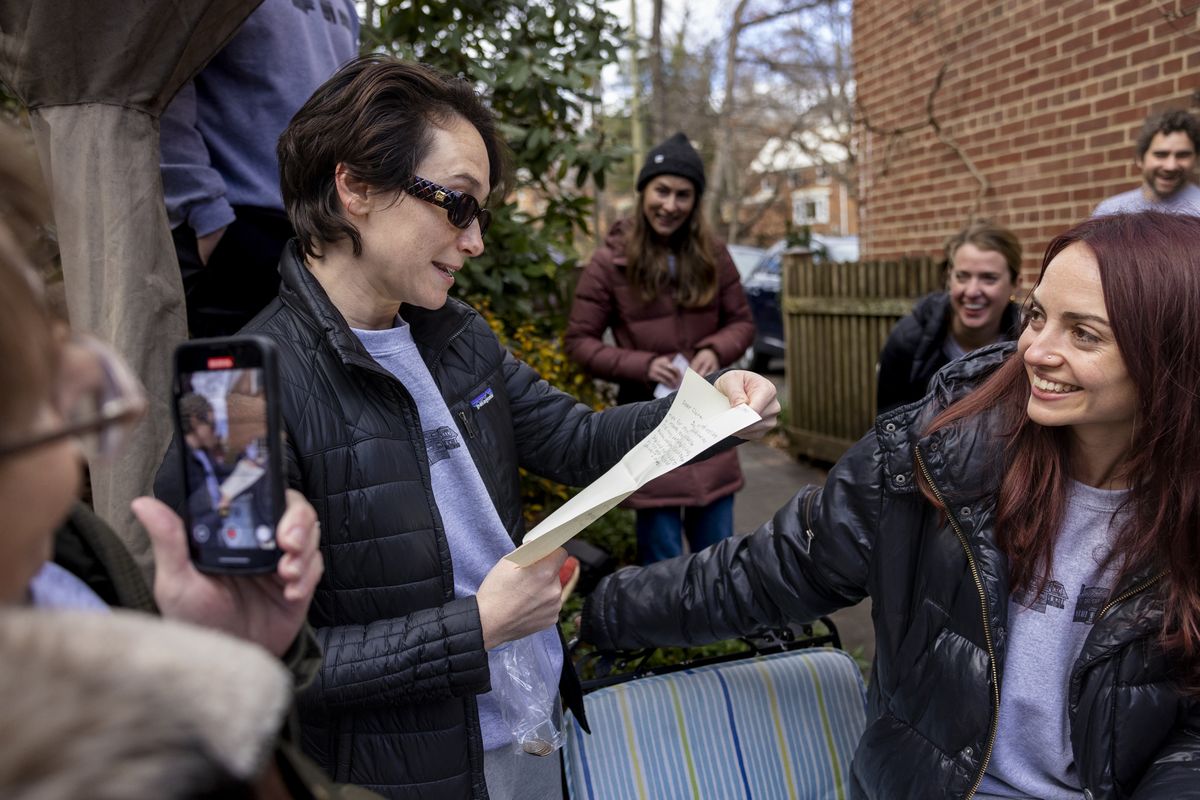Unearthing their Y2K time capsule, millennial friends revisit childhood

As she descended into Maryland woods Wednesday with childhood friends, Claire Murrell couldn’t remember much about what her 10-year-old self was thinking a quarter-century ago, when they buried the time capsule.
That was New Year’s Eve 1999, the precipice of the new millennium, a time marker symbolizing an unknowable future. People were stocking up on gasoline and groceries, spurred by uncertainty over how telecommunications, the electrical grid, bank machines and other systems would handle the feared (yet overblown, it turned out) Y2K bug – meaning the possible inability of computers to handle the year’s new zeros.
Claire was pretty sure her 10-year-old self hadn’t been worried about any of that. She remembered the huge ice cream bowls they made that night in the D.C. suburb of Silver Spring. And she dimly recalled a vision of herself in 2025: She would be married with two children, she thought back then.
The girl’s prediction had not been far off. Now, as she and a group of her long-ago playmates headed toward the spot where a large stone lined up with two tall trees, she pulled out her iPhone to take a selfie with the 8-month-old strapped to her chest. The baby, Claire’s first, was named Alice. She had her mother’s big brown eyes.
Equipped with three shovels and a pickax, they took turns digging. More than 30 people in all, including spouses and others, from four families who’d lived in the hilly neighborhood, where kids grew up wearing paths through the backyards between one another’s brick houses.
The families spent every Friday night together through the fall of 1999 planning their millennium party. The night arrived with an elaborate schedule and menu. The capsule burial was slated for 9 p.m., after the piñata but before the midnight parade of children banging pots and pans along Galveston Road and a 2 a.m. meal, several hours late, of potato-wrapped salmon and herb-crusted tenderloin.
The 10-year-old Claire could have no answers, only hopes and fears and questions, about her future. It would be another year before her best friend developed a crush on a boy named Noah Murrell who lived a couple of streets over. Claire did not consider the gawky, blond-haired middle-schooler worthy of such affection. It was another decade before Claire and Noah became close friends, then years until he unexpectedly kissed her, and still more years before they created a registry with flatware, a turkey roasting pan and espresso machine, and she traded her maiden name of Lieberman for his.
All this time later, as Wednesday’s excavation proceeded, the diggers kept widening the hole where the big stone had been, only to have the oohs and aahs that came with striking something hard be followed by the recognition of another root. The old pickax’s wooden handle snapped. They kept going.
Claire’s mother, Beth Py-Lieberman, lined herself up with the two trees and insisted the diggers move right. Robert Harrelson, the patriarch of one of the other families, agreed. “I think it was over this way,” he said.
Finally, a shovel struck something that sounded hollow, and those peering into the hole, now several feet wide, spotted a flash of white. “I think we got it!” someone yelled. Pretty soon another of the patriarchs, Tim Herbst, was holding a mud-encrusted length of PVC pipe aloft. Then they took it around, letting everyone get a closer look.
Claire approached to let Alice touch the prize. “Yay!” she cooed at the girl, wiping dirt from tiny fingers. Noah stood nearby with the diaper bag. The day was cold, and Alice yawned, her need for a nap apparent. They headed back up to the street.
On Tom and Tamara Buckley’s patio, Herbst and his oldest son, Dan Herbst, plugged in a power saw. They cut around the circumference of the PVC pipe, taking care not to harm its contents, which they soon laid out on the patio table.
There was a cellphone of the pre-flip variety, a bulky black Bell Atlantic brick with an LED screen, plus a Pokémon card, a cassette tape, photographs and a couple of newspapers. “Security, Computers Readied for Real Test,” read one headline. Another article announced the resignation of Russian President Boris Yeltsin, to be replaced by a hard-nosed, 47-year-old former KGB agent named Vladimir Putin. And there were letters that everyone had written to their future selves.
“We will never find this time capsule,” wrote Harrelson, in one of many inaccurate predictions. “The internet was not revolutionary, actually,” Herbst wrote in another.
Someone brought out an old boom box, and they inserted the cassette tape. Soon, 10-year-old Claire introduced herself. “Some things I hope for in the year 2025,” she began. “I hope that there will be a lot easier ways to do things, so you don’t have to clean up your room, and so you can make an invention to do your chores.”
In a note to herself, the Claire of 1999 warned the Claire of 2025 against dying her red-brown hair, and she predicted she would live in Los Angeles near her two best friends.
The notes and mementos appeared undisturbed by their time underground, tucked into zip-top bags alongside moisture-fighting silica gel packets. Through college graduations, careers, relationships, marriages and children, the miracle wasn’t the survival of the capsule’s artifacts, it seemed, but the lasting bonds of four families.